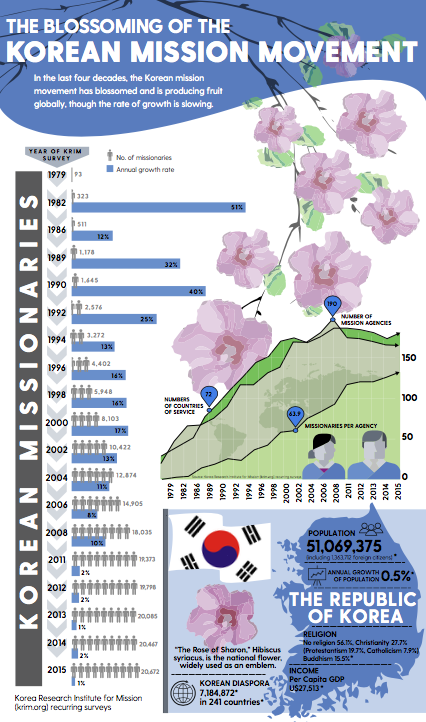30 Oct When Mobilizing Missionaries Works: South Korean Example
As the global Christian church outside of the West continues growing there is a desire by church leaders in Africa, Latin America, Southeast Asia, and Eastern Europe to develop emerging systems of missionary sending. They want to be faithful to Jesus invitation to the Christian church to be ‘senders’ and not merely ‘receivers’ of the Great Commission.
Jesus tells every Christian, and church leader, in Matthew 28:18 that we are to “Go, and make disciples of all nations” (people groups). When a Costa Rican man or a Ukrainian woman reads his or her bible that Jesus is inviting them to participate in His mission they are increasingly ready to respond.
 One example of how missionary sending from the global church, outside of the West, has been effectively activated in recent years is the country of South Korea. The Christian church in South Korea over the last 35 years has become an emerging missionary movement that has resulted in 20,000+ Christian missionaries being sent around the world.
One example of how missionary sending from the global church, outside of the West, has been effectively activated in recent years is the country of South Korea. The Christian church in South Korea over the last 35 years has become an emerging missionary movement that has resulted in 20,000+ Christian missionaries being sent around the world.
According to Korea World Missions Association, an umbrella organization for Korea’s Protestant missionaries, more than 23,000 Korean missionaries have been sent abroad as of January 2012.
Why have so many Christian missionaries from Korea been sent? One obvious reason is that Christianity is a significant presence in Korea. According to recent surveys, nearly 28 percent of Koreans are Christians. Among them, approximately 8 percent were Catholics, and 28 percent were Protestants. (For reference: 56 percent of Koreans do not have any religion. After Christianity, Buddhism is the biggest religion, as nearly 16 percent of Koreans are Buddhists.)
But more importantly, Christian churches in Korea are enthusiastic about sending missionaries because missions was the vehicle through which Korea’s Christianity began. Christianity in Korea was started two centuries ago. Catholicism arrived in Korea in the early 1800s, and the first Korean priest (St. Andrew Kim Taegon, who is also the patron saint of Korea) was ordained in 1845. Protestantism arrived in Korea a bit later, but it was just as fruitful. The Pyongyang Revival of 1907 was a significant event in the church, and some Christians began calling Pyongyang the “Jerusalem of the East.”
Two centuries of church growth in South Korea is a long time, but not long enough for people to forget the origin of their faith. Nearly all major congregations in Korea can trace their origin to a missionary who came to Korea in the early 19th century. In addition, for decades after Korean War, Korea saw a constant stream of American missionaries coming to provide humanitarian aid in the war-torn country, and assist the development of Korean churches.
In 1979 church records indicate that South Korea sent 93 missionaries to foreign locations. By 1989 the number rose to 1,178. Seeing multiplying effectiveness in mission mobilization by 1998 the number of missionaries sent was 5,948. The total number of missionaries sent, and living as missionaries in foreign countries, in the year 2015 was 20,672.
Interestingly in 2013, South Korea ranked No. 5 at 1,014 missionaries sent per million church members, a sign of the continued strength of its mission’s movement compared to the No. 9-ranked United States at 614 missionaries sent per million church members.
This accelerated movement of missionary sending is happening in new places all around the world.
As North American Christians begin to understand the potential for missionary sending from the global church we must begin to think about our potential role in these emerging movements. Is there something we can contribute? Has Christian missions moved on from the Western Church? Are we a hindrance to the future of Christian missions?
God is growing his church around the world and new movements are developing to partner with God in fulfilling the Great Commission.





